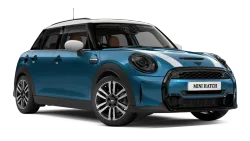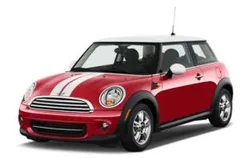

Used Mini Hatch for Sale in Portugal
Explore a wide selection of used Mini Hatch cars for sale in Portugal. Find your dream vehicle at competitive prices and enjoy a seamless car buying experience. Browse listings, compare options, and drive away today!
The Mini Hatch, known for its iconic style and compactness, has made a significant mark in the automotive world since its revival in the early 2000s. The second generation, referred to as the R56, was produced from...
Technical Specifications
Select Version
Dimensions
Engine
Driving
Others
History and Features
Mycarro AI
Apr 26, 2025
The Mini Hatch, known for its iconic style and compactness, has made a significant mark in the automotive world since its revival in the early 2000s. The second generation, referred to as the R56, was produced from 2006 to 2013 and played a crucial role in cementing the Mini's status as a modern classic. As the successor to the R53, the R56 brought along numerous enhancements in terms of design, technology, and performance, appealing to a broader range of buyers while retaining the Mini's quintessential charm.
Design Evolution
The R56 retained much of the styling that made the original Mini so iconic, yet it introduced subtle changes that improved its modernity and aerodynamics. The front fascia was more aggressive, with sharper lines and a prominent grille. The redesigned headlights, with their oval shape, and the larger rear lights created a fresh yet familiar identity. The R56 was slightly larger than its predecessor, providing more interior space without sacrificing the compact nature that Mini enthusiasts loved.
Inside, the R56 placed a strong emphasis on quality and driver experience. The use of higher-quality materials set a new standard, and the circular instrument panel continued the Mini tradition while adding modern touches such as a digital speedometer. The overall interior layout combined retro aesthetics with contemporary features, striking a perfect balance that appealed to a diverse range of customers.
Engine Options and Performance
Under the hood, the R56 introduced several engine options, catering to varying performance needs. The base model featured a 1.6-liter four-cylinder engine that produced 120 horsepower, while the Cooper S variant stepped up the game with a turbocharged version of the same engine, delivering up to 175 horsepower. The efficiency and performance of these engines made the R56 fun to drive, accentuating the Mini's reputation for sporty handling and agility.
One notable feature was the introduction of the turbocharger in certain models, which provided a significant boost in power without sacrificing fuel efficiency. This was an important consideration for buyers looking to balance performance with practicality in an increasingly environmentally-conscious marketplace. The R56 also benefited from Mini's innovative DTC (Dynamic Traction Control) and DSC (Dynamic Stability Control) systems, ensuring a more controlled and engaging driving experience.
Technological Advancements
The R56 was not just about performance—it also embraced technological advancements that were becoming standard in the automotive industry. It featured an array of connectivity options, including optional Bluetooth for hands-free calls, USB ports for music playback, and a premium sound system that enhanced the in-car experience. The introduction of satellite navigation and the Mini Connected app interface further solidified the R56’s status as a modern vehicle, attracting tech-savvy buyers.
Safety was another significant focus of the R56 development. Advanced safety features, including multiple airbags, anti-lock brakes, and stability control systems, were standard across various models, making the Mini a safer option for urban driving. The car also performed well in crash safety tests, contributing to its appeal among buyers seeking security and reliability.
Market Performance and Popularity
Upon its release, the R56 saw strong sales figures, which were bolstered by its unique styling and performance credentials. It appealed to a broad demographic, from young professionals to families looking for a fun and practical vehicle. The Mini’s strong brand identity, combined with its marketing that emphasized individuality and lifestyle, contributed to its popularity during the R56 generation.
Additionally, the strong performance of the R56 helped Mini capture a larger share of the compact car segment. As buyers increasingly sought small vehicles with personality and flair, the Mini Hatch R56 stood out as a top contender, leading to a high retention rate of buyers and a thriving enthusiast community.
Conclusion
The Mini Hatch Generation 2, or the R56, was a notable evolution in the Mini lineup that successfully modernized the classic British icon. With its blend of enhanced design, improved performance, and cutting-edge technology, it paved the way for the future development of the Mini brand. The R56 generation remains a beloved model among enthusiasts and casual drivers alike, proving that this little car can make a significant impact on the automotive landscape. As the Mini continues to innovate, the legacy of the R56 serves as a vital chapter in its history.
